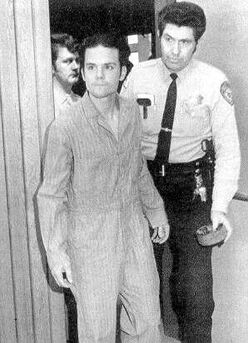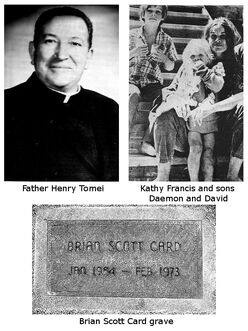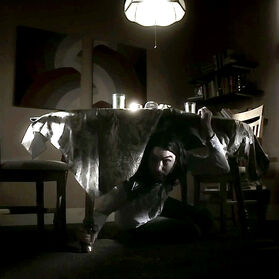"We human beings, through the history of the world, have prevented our continent from cataclysms by murder. In other words, a minor natural disaster avoids a major natural disaster."
Herbert Williams Mullin is an American serial/spree killer active in the early 1970s.
Background
Mullin was born in Salinas, California in 1947, but moved to a farming community outside San Francisco when he was five. His father, Martin William "Bill" Mullin, was a World War II hero who worked as a furniture salesman, taught him how to use a gun and told him war stories. He was strict, though not abusive. The family later moved to Felton in Santa Cruz County, where Herbert attended high school. He was popular, had several friends, a girlfriend and played varsity football. He was also (ironically) voted as "Most Likely To Succeed". After graduating in 1965, he went to college and studied engineering and considered following in his father's footsteps by joining the military. The turning point of his otherwise-normal life came around this time when his best friend, Dean Richardson, was killed in a car accident. His behavior changed entirely and he started building shrines dedicated to him, spending several hours at a time alone at them and became obsessed with the concept of reincarnation. He later came to believe that his friend's demise had been part of some grand cosmic plan. He changed his college major from Engineering to Philosophy and took up independent studies of Eastern religions.
In 1968, Mullin broke up with his girlfriend after voicing his suspicions that he was gay. The next year, he allowed his family to commit him to the Mendocino State Hospital, but he left shortly afterwards. He spent the following years drifting in California working small-time jobs and spending short periods of time in various mental institutions. He did a brief stint as a boxer, but had to be forcibly removed from the ring when he wouldn't stop beating his opponent. He practiced different kinds of alternative lifestyle activities such as yoga, meditation and macrobiotic diets, attempted to join a priesthood, believed in the legalization of LSD and marijuana and used both drugs as well as amphetamine, but was also vocally ultraconservative; in court, he said that he was bi-everything: bisexual, bipolitical, bicultural, bispiritual. He also falsely claimed to be biracial. He was evicted from one of his apartments for pounding the floor and shouting at people he imagined were there. On January 15, 1973, Mullin tried to enlist in the U.S. Marine Corps. Though he passed the physical and psychiatric exams, he was rejected when his pretty extensive record of arrests and bizarre behavior was discovered. He believed this to be another part of a big conspiracy against him and later stated that he never would have become a serial killer if he had been accepted. In November the previous year, he had also applied for the Coast Guard, but failed the psychiatric exam.
Killings, Arrest and Incarceration
Over time, Mullin began suffering from schizophrenic delusions, hearing voices that told him to kill. In October of 1972, he finally snapped and bludgeoned a hitchhiking homeless man, Lawrence White, to death with a baseball bat. Less than two weeks later, he picked up a hitchhiking woman, Mary Guilfoyle, killed her inside the car, dumped her body in the woods by the roadside, dissected her, hanged her intestines in tree branches and examined them for "pollution". Her remains weren't found for several months, and when they were discovered, her murder was initially believed to be the work of Edmund Kemper, another serial killer who was active in Santa Cruz at the same time. Four days after killing Guilfoyle, on All Souls' Day, Mullin went to the St. Mary's Catholic Church and made a confession to a priest, Father Henry Tomei. Thinking he offered himself as a sacrifice, Mullin stabbed him to death and fled the scene. After being rejected by the USMC and quitting taking drugs, his delusions became worse and he decided to kill Jim Gianera, whom he knew from high school and used to buy marijuana from; he felt that, because he had sold him drugs that had twisted his mind, he was to blame for how troubled his life was. On January 25, 1973, he went to the last address he knew Gianera had lived, a cabin near the Mystery Spot, a tourist attraction in Santa Cruz. When he found that the cabin had another resident, a woman named Kathy Francis and her two sons, he got Gianera's new address from her. During that night, Mullin went to the Gianera's home on West Avenue and killed him and his wife and, at some point, killed Francis and her sons. Exactly in what order the murders occurred is uncertain, though an FBI profiler asserted that Mullin killed the Francises just after talking to the mother and then killed the Gianeras. Because both Jim Gianera and Kathy Francis' husband, Bob Francis, were drug dealers, the police thought the murders were drug related and Mullin was not considered a suspect.

Mullin (left) being led to trial.
Less than two weeks later, Mullin saw four teenage boys camping in Henry Cowell Redwoods State Park and approached them, posing as a park ranger. He told them to leave, claiming that they were "polluting" the forest. When they dismissed him, he pulled out a gun and shot them one by one, later stating that he had asked them telepathically if he could kill them and that they had all given him permission. A week later, on February 13, he used a rifle taken from the campsite to shoot and kill a man named Fred Perez. When a witness called for help, a police officer arrested Mullin, who didn't put up any resistance at all. At the police station, Mullin was completely uncooperative, shouting "Silence!" as response to every single question. When Edmund Kemper was arrested, he and Mullin were briefly held in adjoining cells, where Kemper accused him of stealing his dump sites. He was charged with six counts of murder when evidence was found in his apartment. Four more counts, those of the campers, were added when their bodies were discovered on February 17 and he soon confessed to the first three murders, though he was not charged with them. A big issue during the trial was establishing whether or not he was eligible for the insanity plea. It was argued that his murders of the Gianeras and the Francises had some degree of premeditation. In the end, Mullin was found guilty of eight counts of second-degree murder (meaning he hadn't planned them in advance) and two counts of first-degree murder, those of Kathy Francis and Jim Gianera, and sentenced to life imprisonment. He is currently serving his sentence at the Mule Creek State Prison in Ione, California and won't be eligible for parole until 2025, when he will be 78 years old.
Modus Operandi
Mullin targeted random people of both genders and various ages and races. He killed them in different ways, mostly by shooting but also by stabbing and bludgeoning. Sometimes, he knew the victims personally. Initially, he only killed one victim at a time, but later started killing whole groups of people.
Profile
Mullin had a fixation with earthquakes and believed that his birthday, April 18, had some significance because it is the anniversary of the 1906 San Fransisco earthquake and also the anniversary of the death of Albert Einstein; on the witness stand, he asserted that he had been "chosen as the designated leader of his generation". He believed that the many killings in North Vietnam during the Vietnam war had acted as a kind of sacrifices and prevented earthquakes and that his own killings had the same effect on California, where earthquakes of various intensities are frequent, and that as the "leader" it was his duty to ensure that enough people died to prevent natural disasters. Prior to that, he had considered relocating to Canada in order to avoid them. He also came to believe that everything about his life had been part of a big conspiracy. He believed that his parents had been "killjoy reincarnationalists" who believed their next lives would be more enjoyable if they made those of others miserable and that his rejection by the U.S. military had been a part of a the conspiracy, as had his parents.
Known Victims

Several of Mullin's victims.
- 1972:
- October 13: Lawrence White, 55 (bludgeoned with a baseball bat)
- October 24: Mary Guilfoyle, 24 (stabbed and eviscerated)
- November 2: Father Henry Tomei, 65 (stabbed)
- 1973:
- January 25:
- Jim Ralph and Joan Gianera (both were shot in the head and stabbed repeatedly):
- Jim Ralph, 25
- Joan Gianera, 21
- The Francis family (all were shot):
- Kathy Francis, 29 (mother)
- Daemon Francis, 4 (son)
- David Hughes, 9 (son)
- Jim Ralph and Joan Gianera (both were shot in the head and stabbed repeatedly):
- February 6: Four teenagers killed at the Henry Cowell Redwoods State Park shooting. They are:
- David Allan Oliker, 18
- Robert Michel Spector, 18
- Brian Scott Card, 19
- Mark John Dreibelbis, 15
- February 13: Fred Perez, 72 (shot with a rifle)
- January 25:
On Criminal Minds

Mullin in a flashback in The Eyes Have It.
Mullin was first mentioned in Plain Sight when Reid names him as an example of a serial killer with no victimology, meaning he killed with almost complete randomness. He was mentioned again in The Eyes Have It when it is believed that the unsub was also delusional and mission-driven. The comparison is accompanied by a flashback in which Mullin (who is portrayed by Marco Aiello) first cowers under a table during an earthquake and is then seen picking up a female hitchhiker and attacking her inside his car, apparently a flashback of his murder of Mary Guilfoyle. While he wasn't mentioned in With Friends Like These..., the scene where the unsub visits a priest for an exorcism seems to be a callback to Mullin's visit to Father Tomei. The only difference is Mullin killed the priest, while the unsub didn't (although it can be initially assumed that he did so due to the rage he flew into before the scene abruptly cut out). While he wasn't mentioned or referenced in The Last Word, the fact that he was active at the same time as Edmund Kemper might have been one of many inspirations for the episode's two prominent unsubs, The Mill Creek Killer and The Hollow Man.
